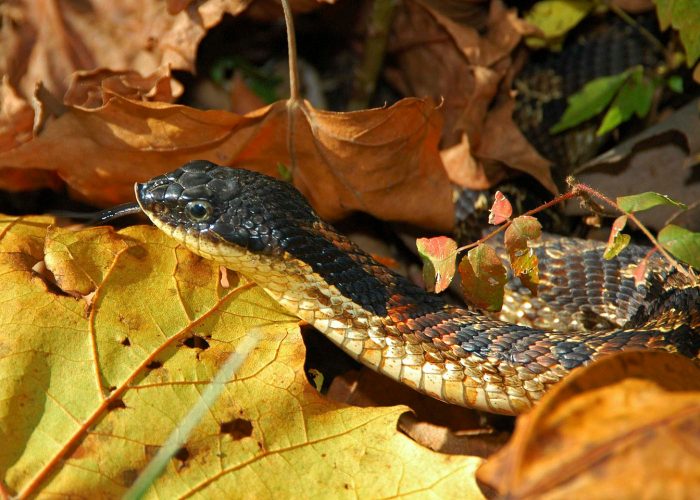Getting to know wildlife in West Virginia is another reason to appreciate the beauty the landscape provides. Among some of these animals are snakes and other reptiles. These members of the reptile class play a vital role in the balance of nature. Their colorful and complex life histories are fascinating and give little justification for the apprehension felt by so many.
The fear of being bitten causes many persons to senselessly kill any snake they see. Yet, of the 20 species of snakes found in the Mountain State, only two are venomous, the Northern Copperhead and Timber Rattlesnake. Although most venomous snake bites in West Virginia are from copperheads, no fatalities from copperheads have been recorded in over 30 years. From 1969 to 1992 only four people in the Mountain State have died from rattlesnake bites while in the wild. Bee stings, cows and horses caused 15 times as many deaths as snakes. Up to one-half of venomous snake bites result in no venom being injected. If, however, you are bitten by a venomous snake, see a doctor or go to a hospital immediately.
Their main prey consists of rodents and small mammals, which they subdue using hemotoxic venom. They are members of the Pit Viper family, for they possess heat-sensitive pits that allow them to locate warm-blooded animals. Even though these snakes aren’t particularly aggressive, many are needlessly killed every year.
Despite their reputation, all of the other 18 species are completely harmless. There is a broad diversity of body forms, diet, habitat preference, color and behavior within the colubrids. Some live-in streams, while others live in trees. Many are small and secretive, spending much of their time eating invertebrates while hiding under rocks or logs. Others can grow quite large, employing constriction as a means of subduing prey. All are carnivores, feeding on a wide variety of prey, including: insects, spiders, crustaceans, earthworms, amphibians, fish, rodents, birds, lizards, and smaller snakes.
Some of West Virginia’s snakes are very common, such as the Eastern Gartersnake and Black Ratsnake, and can be found all over (even in backyards). Others, such as the Cornsnake and Northern Pinesnake, have only been documented a few times over the years. Always be on the lookout in case one shows up in your area. Snakes have a way of bringing about a certain intense fear in many individuals. This irrational hatred has been passed down throughout history. Hopefully, by reading about these fascinating animals, many people will be able to realize the important (and necessary) role they play in the ecosystem.

